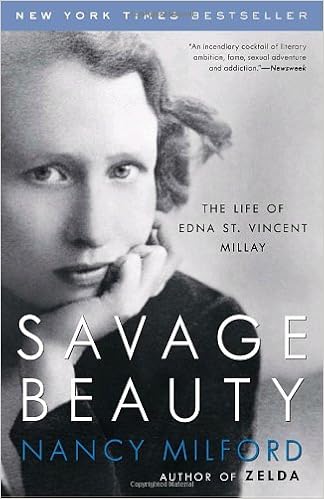
Per the forward to this long bio, Milford’s the first to have been granted access to the poet Edna St. Vincent Millay’s private letters and journals, long held in keeping by her sister Norma. This helps explain why this narrative is so compelling: having access to the subject’s own journals and letters provides fascinating access to her internal as well as external life. However, this may also explain the frustrating limits of this narrative: basically, if an incident isn’t covered in the letters, it isn’t mentioned here – leading to a biography that feels weirdly limited and insular. Moreover, while letters and diary entries may be revealing, they’re not necessarily complete, and they’re not necessarily trustworthy. In this case, it’s necessary to remember that our subject, Millay, wasn’t just a poet – she was also an accomplished actress, an erratic diarist with a tendency to omit unpleasant events, and an expert manipulator (especially of men and older women) with a gift for self-delusion. At the end of 500 pages I guarantee you’ll know a lot more about Millay, her life, and her canon; just don’t expect to have gained much insight into the forces that likely played the greatest role in shaping her life and character, which (based on clues in this text) may have included abandonment issues, bipolar disorder, and childhood sexual trauma.
There’s way too much drama in Millay’s life to try to summarize here, from her oddly heartbreaking childhood to her wild, bohemian adulthood to her early death following increasingly dramatic hospitalizations and staggering drug use. What Milford seems intent upon us understanding is that, as worthy as Millay’s poetry may have been, her fame was also in large part indebted to her ability to create her own “cult of personality.” If it hadn’t been for the willingness of a succession of older women, dazzled by her talent and charm, to smooth her path to and through college; if it hadn’t been for a string of discarded lovers, enchanted by her beauty, intensity, and sexual precocity, to ensure her poems stayed constantly in the public eye; if it hadn’t been for her scores of fans, particularly “sexually liberated young women,” enthralled by her dramatic public readings, her risqué reputation, and her husky contralto voice, flocking to the stores to purchase her poetry – one wonders whether she would have become what she became: the first woman to win a Pulitzer Prize for poetry and the “voice of her era.” For if F. Scott Fitzgerald can be said to have given the “Jazz Age” its voice, then Millay can surely be said to have written the libretto.
Which brings me to the quirks of Milford as a narrator. She has the oddest habit of introducing new characters without any preamble and minimal biographical information, making it very difficult to figure out which characters are “minor” and which “major.” It was frustrating to constantly have to double back to re-read character introductions when the characters suddenly reappeared, 100 pages later, without any helpful reference or context. Even the minimal biographical information she provides sometimes comes chapters after the characters have been introduced, long after it would have been useful to have. Another issue I had was with Milford’s apparent resolve to present information without endeavoring to interpret it. In general I’m grateful when biographers eshew psychobabble – but isn’t there also something a little unhelpful (if not irresponsible) about presenting two fairly significant clues that Millay was the victim of childhood sexual trauma at the hands of one (or more) of her mother’s lovers with as much detachment as she brings to reprinting Millay’s endless letters about fashion? About as far as Milford goes is to acknowledge that when Millay starts using baby talk in her letters to her family, it’s “a bad sign” – though she coyly declines suggest what it’s a bad sign of.
On the other hand, you could argue that this approach, at the least, provides ample fodder for book club discussion! Some of the questions my group wrestled with (and that I’m still wrestling with): What was the root cause of Vincent’s sexual precocity – was it a Jazz Age thing? A poet thing? A Greenwich Village/bohemian thing? A symptom of a childhood sexual trauma? A desperate cry for attention/love? How did regularly society react to her many affairs with women and married men – or, what explains their failure to react? Did the babying she received at the hands of her husband Eugin truly protect her from her mistakes, or merely enable her to continue making them? Were her many illnesses real or psychosomatic? When did she begin using morphine, and what role did it play in hastening her nervous breakdowns? Or do Millay’s alternating episodes of mania and depression provide evidence that she was struggling with bipolar disorder? What exactly were her true feelings towards the mother she outwardly adored, but who in fact abandoned her daughters for long periods of time and seems, throughout this narrative, much more interested in being Vincent’s BFF than protecting her from harm? And finally, the biggest question of all: after reading this 500 page biography, why are we all struggling with the feeling that this narrative omits almost as much valuable insight as it includes?
No comments:
Post a Comment